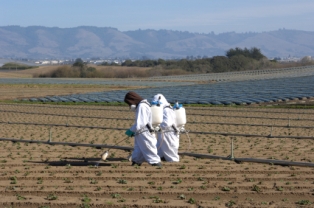Parkinson’s and Pesticides
Pesticide Use Poses Problems For Farmers
Every year, the Bureau of Labor Statistics compiles a list of the world’s most dangerous jobs based on how many people died while at the job site. In 2008, for example, of the 5,000+ reported on-the-job deaths, fishermen ranked number one.
Other “deadly” jobs in 2008 were in the logging industry, the aircraft industry, and the transportation industry among taxi drivers, and refuse workers.
Another profession where hundreds of lives were lost—317, to be specific—was in farming. Most of these deaths were due to freak accidents where heavy machinery was involved, making it the fifth deadliest jobs in America.
One thing the Bureau of Labor Statistics doesn’t compile a list of is jobs that increase the risk of obtaining a disease. If they did, farming would be chief among them.
According to a new study in the journal Archives of Neurology, farmers that work with pesticides dramatically increase their risk for Parkinson’s disease. What’s more, among three specific pesticides, that risk is three times higher than among other pesticides!
The study was really more of a survey, as the researchers involved asked 519 people with Parkinson’s about their occupational history and how often they were around pesticides. They also interviewed 511 other people who served as controls. These people did not have Parkinson’s but lived in the same area as those with Parkinson’s.
Among those with Parkinson’s, about 10 percent of them had a job that had them around pesticides frequently, like farming. This is in stark comparison to the healthy controls, where about 5 percent of them reported being around pesticides through work.
That pesticides increase the risk of Parkinson’s is nothing new, though, as studies going back to the 19th century have found links between pesticide use and Parkinson’s. What hasn’t been analyzed is what specific pesticides increase that risk.
To answer that question, researchers analyzed eight highly toxic pesticides. According to their analysis, all eight of them put someone at double the risk for obtaining Parksinson’s compared to those who are never around them, but three pesticides put someone at triple the risk!
The trifecta of trouble are 2,4 dichlorophenoxyacetic acid, paraquat, and permethrin. The researchers report that all three affect the levels at which the brain can transmit dopamine, the neurotransmitter that controls movement.
Parkinson’s disease is a neurological disorder. It manifests itself through a number of symptoms, like rigidity, improper balance, slowness of movement, tremor-like motions (shaking uncontrollably) and muffled speech. While the cause for this disease remains unknown, it results from the brain being unable to transmit neurotransmitters that control movement.
While Parkinson’s is diagnosed overwhelmingly among men and women over the age of 65, 15 percent of those with Parkinson’s are under the age 50 (Michael J. Fox is perhaps the most well-known example). Approximately one million people in the United States have Parkinson’s, and an estimated 60,000 people are newly diagnosed with it every year.
Sources:
sciencedaily.com
msnbc.msn.com
telegraph.co.uk
parkinson.org
Related Posts
 
|
Enjoy this article? We guarantee your privacy. Your email address will NEVER be rented, traded or sold. |
Visit my new site: Self Help On The Web
 |
 |
Posted: September 24th, 2009 under Parkinson’s disease.
Tags: 2 4 dichlorophenoxyacetic acid, farming, michael j. fox, neurological disorder, paraquat, permethrin, pesticides







